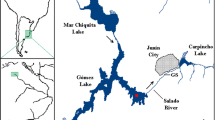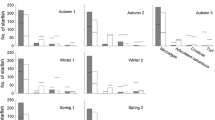Abstract
The isopod Idotea baltica is the most important benthic herbivore in the Baltic Sea. There exists a significant correlation between the distribution of the adult isopod and the belts of bladder wrack Fucus vesiculosus. However, following the eutrophication induced blooms of the filamentous macroalga Pilayella littoralis and the disappearance of F. vesiculosus a notable increase in idoteid abundances has been observed. The aim of this paper was (1) to evaluate experimentally whether F. vesiculosus provides either food, shelter or both to the isopods and (2) to estimate the role of associated filamentous algae in the habitat selection process. Amongst six abundant macroalgal species, about 50% of isopod population was attracted to F. vesiculosuscovered with the filamentous algae P. littoralis. The majority of the remaining part of the population was either swimming freely or attracted to non-epiphytic P. littoralis. When both live algae and artificial substrata were provided, P. littoralis growing on artificial substrata was clearly preferred by the isopods over epiphyte-free F. vesiculosus. In the grazing experiment where I. baltica was allowed to choose between F. vesiculosus and P. littoralis the latter contributed practically 100% of the diet of the isopod. The results indicate the importance of P. littoralis as a food item and F. vesiculosus as a shelter for I. baltica.
Similar content being viewed by others
References
Arrontes, J., 1990. Diet, food preference and digestive efficiency in intertidal isopods inhabiting macroalgae. J. Exp. Mar. Biol. Ecol. 139: 231–249.
Birch, P. B., J. O. Gabrielson & K. S. Hamel, 1983. Decomposition of Cladophora I. Field studies in the Peel-Harvey estuarine system, western Australia. Bot. Mar. 26: 165–171.
Bonsdorff, E., E. M. Blomqvist, J. Mattila & A. Norkko, 1997. Coastal eutrophication: cause, consequences and perspectives in the archipelago areas of the northern Baltic Sea. Estuar. Coast. Shelf Sci. 44: 63–72.
Boström, C. & E. Bonsdorff, 1997. Community structure and spatial variation of benthic invertebrates associated with Zostera marina (L.) beds in the northern Baltic Sea. J. Sea Res. 37: 153–166.
Boström, C. & J. Mattila, 1999. The relative importance of food and shelter for seagrass-associated invertebrates: a latitudinal comparison of habitat choice by isopod grazers. Oecologia 120: 162–170.
Brawley, S. H. & W. H. Adey, 1981. The effect of micrograzers on algal community structure in a coral reef microcosm. Mar. Biol. 61: 167–177.
Brawley, S. H. & X. G. Fei, 1987. Studies of mesoherbivory in aquaria and in unbarricaded mariculture farm on the Chinese coast. J. Phycol. 23: 614–623.
Bäck, S., A. Lehvo & J. Blomster, 2000. Mass occurrence of unattached Enteromorpha intestinalis on the Finnish Baltic Sea coast. Ann. Bot. Fennici 37: 155–161.
Carlson, L., 1991. Seasonal variation in growth, reproduction and nitrogen content of Fucus vesiculosus L. in the Öresund, southern Sweden. Bot. Mar. 34: 447–453.
D'Antonio, C., 1985. Epiphytes on the rocky intertidal red alga Rhodomela larix (Turner) C. Agardh: negative effects on the host and food for herbivores? J. Exp. Mar. Biol. Ecol. 86: 197–218.
Duffy, J. E., 1990. Amphipods on seaweeds: partners or pests? Oecologia 83: 267–276.
Franke, H.-D. & M. Janke, 1998. Mechanisms and consequences of intra-and interspecific interference competition in Idotea baltica (Pallas) and Idotea emarginata (Fabricius) (Crustacea: Isopoda): A laboratory study of possible proximate causes of habitat segregation. J. Exp. Mar. Biol. Ecol. 227: 1–21.
Gabrielson, J. O., P. B. Birch & K. S. Hamel, 1983. Decomposition of Cladophora II. In vitro studies of nitrogen and phosphorus regeneration. Bot. Mar. 26: 173–179.
Haahtela, I., 1981. Probable reasons for the decline of the bladder wrack Fucus vesiculosus L. in SW Finland. Rep. Dept. Biol., University Turku 2: 18-21.
Haahtela, I., 1984. A hypothesis of the decline of the Bladder Wrack (Fucus vesiculosus L.) in SW Finland in 1975-1981. Limnologica 15: 345–350.
Hacker, S. D. & L. P. Madin, 1991. Why habitat architecture and colour are important to shrimps living in pelagic Sargassum: Use of camouflage and plant-part mimicry. Mar. Ecol. Prog. Ser. 70: 143–15.
Jansson A.-M., 1974. Community structure, modelling and simulation of the Cladophora ecosystem in the Baltic area. Contr. Askö Lab., University Stockholm 5: 1–130.
Jernakoff, P., A. Brearley & J. Nielsen, 1996. Factors affecting grazer epiphyte interactions in temperate seagrass meadows. Oceanogr. Mar. Biol. Ann. Rev. 34: 109–162.
Jernakoff, P. & J. Nielsen, 1996. The relative importance of amphipod and gastropod grazing in Posidonia sinuosa meadows. Aquat. Bot. 56: 183–202.
Jormalainen, V., T. Honkanen & N. Heikkilä, 2001. Feeding preferences and performance of amarine isopod on seaweed hosts: cost of habitat specialization. Mar. Ecol. Prog. Ser. 220: 219–230.
Kangas, P., H. Autio, G. Hällfors, H. Luther, Å. Niemi & H. Salemaa, 1982. A general model of the decline of Fucus vesiculosus at Tvärminne, south coast of Finland in 1977-1981. Acta Bot. Fenn. 118: 1–27.
Kotta, J., T. Paalme, G. Martin & A. Mäkinen, 2000. Major changes in macroalgae community composition affect the food and habitat preference of Idotea baltica. Int. Rev. Hydrobiol. 85: 697–705.
Lehvo, A. & S. Bäck, 2001. Survey of macroalgal mats in the Gulf of Finland, Baltic Sea. Aquat. Conserv. Mar. Freshw. Ecosyst. 11: 11–18.
Main, K. L., 1987. Predator avoidance in seagrass meadows: prey behaviour, microhabitat selection, and cryptic coloration. Ecology 68: 170–180.
Mann, K. H., 1988. Production and use of detritus in various freshwater, estuarine, and coastal marine ecosystems. Limnol. Oceanogr. 33: 910–930.
Merilaita, S. & V. Jormalainen, 2000. Different roles of feeding and protection in diel microhabitat choice of sexes in Idotea baltica. Oecologia 122: 445–451.
Naylor, E., 1955. The ecological distribution of British species of Idotea (Isopoda). J. Anim. Ecol. 24: 255–269.
Neckles, H. A., R. L. Wetzel & R. J. Orth, 1993. Relative growth of nutrient enrichment and grazing on epiphyte-macrophyte (Zostera marina) dynamics. Oecologia 93: 285–295.
Nicotri, M. E., 1980. Factors involved in herbivore food preference. J. Exp. Mar. Biol. Ecol. 42: 13–26.
Norkko, J., E. Bonsdorff & A. Norkko, 2000. Drifting algal mats as an alternative habitat for benthic invertebrates: Species specific responses to a transient resource. J. Exp. Mar. Biol. Ecol. 248: 79–104.
Paalme, T., H. Kukk, J. Kotta & H. Orav, 2002. In vitro and in situ decomposition of nuisance macroalgae Cladophora glomerata and Pilayella littoralis. Hydrobiologia, 475/476: 469–476.
Pavia, H., H. Carr & P. Åberg, 1999. Habitat and feeding preferences of crustacean mesoherbivores inhabiting the brown seaweed Ascophyllum nodulosum (L.) Le Jol. and its epiphytic macroalgae. J. Exp. Mar. Biol. Ecol. 236: 15–32.
Puttman, R. J., 1986. Grazing in Temperate Ecosystems: Large Herbivores and the Ecology of the New Forest. Croom Helm, London.
Ravanko, O., 1969. Benthic algae as food for some invertebrates in the inner part of the Baltic. Limnologica 7: 203–205.
Robertson, A. I. & J. S. Lucas, 1983. Food choice, feeding rates, and the turnover of macrophyte biomass by a surf-zone inhabiting amphipod. J. Exp. Mar. Biol. Ecol. 72: 99–124.
Robertson, A. I. & K. H. Mann, 1980. The role of isopods and amphipods in the initial fragmentation of eelgrass detritus in Nova Scotia, Canada. Mar. Biol. 59: 63–69.
Salemaa, H., 1978. Geographical variability in the colour polymorphism of Idotea baltica (Isopoda) in the northern Baltic. Hereditas 88: 165–182.
Salemaa, H., 1979. Ecology of the Idotea spp. (Isopoda) in the Northern Baltic. Ophelia 18: 133–150.
Salemaa, H., 1987. Herbivory and microhabitat preferences of Idotea spp. (Isopoda) in the northern Baltic Sea. Ophelia 27: 1–15.
Schaffelke, B., D. Evers & A. Walhorn, 1995. Selective grazing of the isopod Idothea baltica between F. evanescens and F. vesiculosus from Kiel Fjord (Western Baltic). Mar. Biol. 124: 215–218.
Schramm, W., H. K. Lotze & D. Schories, 1996. Eutrophication of macroalgal blooms in inshore waters of the German Baltic coast: The Schlei Fjord, a case study. EUMAS synthesis report, NIOO, Yerseke, The Netherlands.
Shacklock, P. F. & R. W. Doyle, 1983. Control of epiphytes in seaweed cultures using grazers. Aquaculture 31: 141–151.
Sokal, R. R. & F. J. Rohlf, 1981. Biometry: the Principles and Practice of Statistics in Biological Research. W.H. Freeman & Company, San Francisco.
Stoner, A. W., 1980. Perception and choice of substratum by epifaunal amphipods associated with seagrasses. Mar. Ecol. Prog. Ser. 3: 105–111.
Sywula, T., 1964. A study on the taxonomy, ecology and geographical distribution of species of genus Idotea Fabricius (Isopoda, Crustacea) in Polish Baltic. 1 and 2. Bull. Soc. Amis. Sci. Lettr. Poznana. Ser. D 4: 141–200.
Tuomi, J., H. Ilvessalo, P. Niemelä, S. Sirén & V. Jormalainen, 1989. Within-plant variation in phenolic content and toughness of the brown alga Fucus vesiculosus L. Bot. Mar. 32: 505–509.
Vahteri, P., A. Mäkinen, S. Salovius, & I. Vuorinen, 2000. Are drifting algal mats conquering the bottom of the archipelago sea, SW Finland? Ambio 29: 338–343.
Williams, S. L. & H. M. Ruckelshaus, 1993. Effects of nitrogen availability and herbivory on eelgrass (Zostera marina) and epiphytes. Ecology 74: 904–918.
Williams, G. A. & R. Seed, 1992. Interactions between macrofaunal epiphytes and their host algae. In John, D. M. & S. J. Hawkins (eds), Plant-Animal Interactions in theMarine Benthos. Systematics Association Special 46: 189–211.
Worm, B. & U. Sommer, 2000. Rapid direct and indirect effects of a single nutrient pulse in a seaweed-epiphyte-grazer system. Mar. Ecol. Prog. Ser. 202: 283–288.
Author information
Authors and Affiliations
Rights and permissions
About this article
Cite this article
Orav-Kotta, H., Kotta, J. Food and habitat choice of the isopod Idotea baltica in the northeastern Baltic Sea. Hydrobiologia 514, 79–85 (2004). https://doi.org/10.1023/B:hydr.0000018208.72394.09
Issue Date:
DOI: https://doi.org/10.1023/B:hydr.0000018208.72394.09




